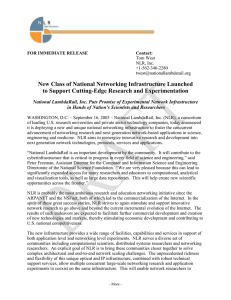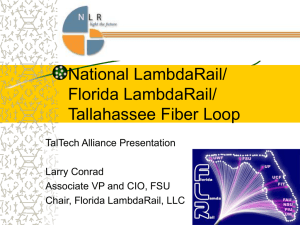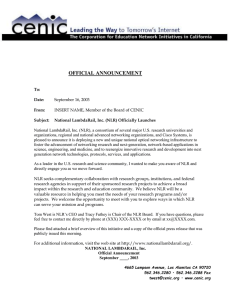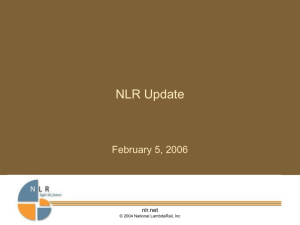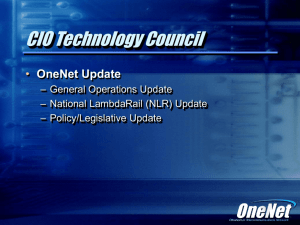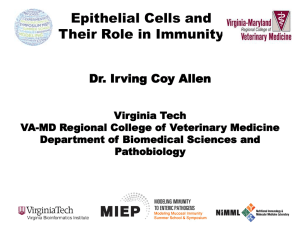FINAL_NLR_Annoument_09160_21.doc
advertisement
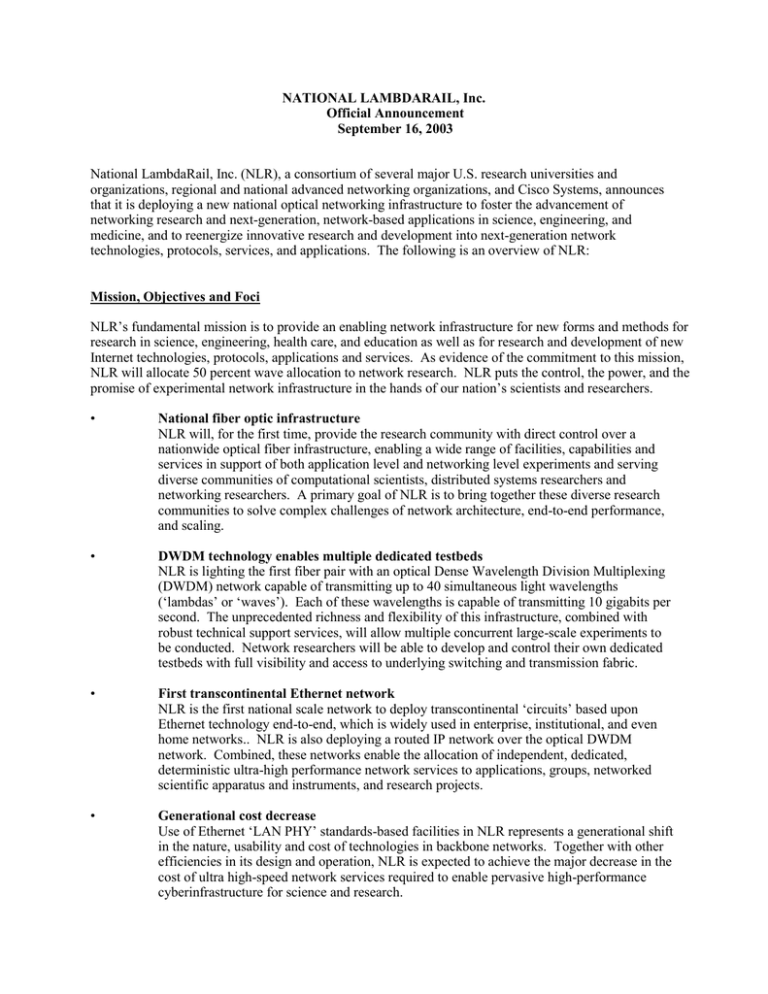
NATIONAL LAMBDARAIL, Inc. Official Announcement September 16, 2003 National LambdaRail, Inc. (NLR), a consortium of several major U.S. research universities and organizations, regional and national advanced networking organizations, and Cisco Systems, announces that it is deploying a new national optical networking infrastructure to foster the advancement of networking research and next-generation, network-based applications in science, engineering, and medicine, and to reenergize innovative research and development into next-generation network technologies, protocols, services, and applications. The following is an overview of NLR: Mission, Objectives and Foci NLR’s fundamental mission is to provide an enabling network infrastructure for new forms and methods for research in science, engineering, health care, and education as well as for research and development of new Internet technologies, protocols, applications and services. As evidence of the commitment to this mission, NLR will allocate 50 percent wave allocation to network research. NLR puts the control, the power, and the promise of experimental network infrastructure in the hands of our nation’s scientists and researchers. • National fiber optic infrastructure NLR will, for the first time, provide the research community with direct control over a nationwide optical fiber infrastructure, enabling a wide range of facilities, capabilities and services in support of both application level and networking level experiments and serving diverse communities of computational scientists, distributed systems researchers and networking researchers. A primary goal of NLR is to bring together these diverse research communities to solve complex challenges of network architecture, end-to-end performance, and scaling. • DWDM technology enables multiple dedicated testbeds NLR is lighting the first fiber pair with an optical Dense Wavelength Division Multiplexing (DWDM) network capable of transmitting up to 40 simultaneous light wavelengths (‘lambdas’ or ‘waves’). Each of these wavelengths is capable of transmitting 10 gigabits per second. The unprecedented richness and flexibility of this infrastructure, combined with robust technical support services, will allow multiple concurrent large-scale experiments to be conducted. Network researchers will be able to develop and control their own dedicated testbeds with full visibility and access to underlying switching and transmission fabric. • First transcontinental Ethernet network NLR is the first national scale network to deploy transcontinental ‘circuits’ based upon Ethernet technology end-to-end, which is widely used in enterprise, institutional, and even home networks.. NLR is also deploying a routed IP network over the optical DWDM network. Combined, these networks enable the allocation of independent, dedicated, deterministic ultra-high performance network services to applications, groups, networked scientific apparatus and instruments, and research projects. • Generational cost decrease Use of Ethernet ‘LAN PHY’ standards-based facilities in NLR represents a generational shift in the nature, usability and cost of technologies in backbone networks. Together with other efficiencies in its design and operation, NLR is expected to achieve the major decrease in the cost of ultra high-speed network services required to enable pervasive high-performance cyberinfrastructure for science and research. • Additional dark fiber pairs available The optical waves enable building networking research testbeds at switching and routing layers with the ability to re-direct real user traffic over them for testing purposes. For optical layer research testbeds additional dark fiber pairs are available on the national footprint. • Commitment to extending capabilities to the campus Integral to the overall plan is each participants’ commitment to work to further improve endto-end network performance by providing dedicated optical capabilities from campus research laboratories to integrate seamlessly with the NLR network. To this end, NLR will work closely with the growing set of regional optical networking initiatives to deliver NLR capabilities to the campuses. NLR is anticipated to spur the development of other such efforts around the country. • Promise of technology transfer Just as the creation of NSFnet led to commercialization of the Internet, a goal of NLR is to enable technology transfer into commercial development and creation of new markets, and therefore stimulate economic development and contribute to U.S. national competitiveness. Organization, Membership and Partnership • On May 5, 2003 National LambdaRail, Inc. was officially formed as a new not-for-profit organization to carry out this initiative. NLR’s current members and associates include: the Corporation for Education Network Initiatives in California (CENIC); Pacific Northwest GigaPop (PNWGP); Pittsburgh Supercomputing Center; Duke University, representing a coalition of North Carolina Universities; Mid-Atlantic Terascale Partnership (MATP) and the Virginia Tech Foundation; Cisco Systems; Internet2®; Florida LambdaRail, LLC; Georgia Institute of Technology; and the Committee on Institutional Cooperation (CIC). • The Texas Universities Consortium is a pending NLR member. • NLR is open for other groups and major corporations actively engaged in high-performance networking research and development to become members. • NLR seeks collaboration with federal research agencies and major research groups in support of their sponsored research projects to achieve a broad impact within the research and education community. One goal is to significantly enhance U.S. research and academia’s collaborative capabilities and overall competitiveness in international efforts. • Critical to the effort is the participation of Cisco Systems, which has made a significant financial commitment in support of the NLR networking research objectives. In addition, in support of these objectives and by extending and leveraging its university research grant programs, Cisco intends to sponsor networking research projects at NLR member institutions. NLR is currently seeking additional corporate participation. Technology and Implementation • NLR has acquired enabling technologies for the project. Cisco has provided enabling technologies including optical DWDM multiplexers, Ethernet switches and IP routers for deployment of NLR infrastructure. Fiber optic cable and supporting services are being provided by Level 3 Communications. • Implementation plans tentatively call for deploying the equipment from: Chicago to Pittsburgh by mid-November 2003; Sunnyvale to Seattle, by early December 2003; Pittsburgh to Washington D.C. by early January 2004; Washington D.C. to Atlanta by mid-February 2004; Atlanta to Jacksonville by early April 2004; Chicago to Denver by the end of April 2004; and Denver to Seattle by the end of April 2004. Implementation of Atlanta to Dallas is pending the Texas Universities Consortium joining NLR. Implementation from Washington D.C. to New York to Boston is contingent upon groups in the northeast working with NLR. Investment Funding and Costs • The founding members together have secured the critical mass of funding commitments needed to commence the initial transcontinental network infrastructure deployment including the first four waves. • NLR members view their financial commitments as an investment in both next generation research and a new class of optical networking facilities capable of serving distinct applications and users concurrently with dedicated capabilities. • Research groups can acquire dedicated waves between and amongst specific locations on the NLR infrastructure. Pricing quotes are available upon request. • A cost schedule matrix has been developed for the additional unlit wave capacity.
